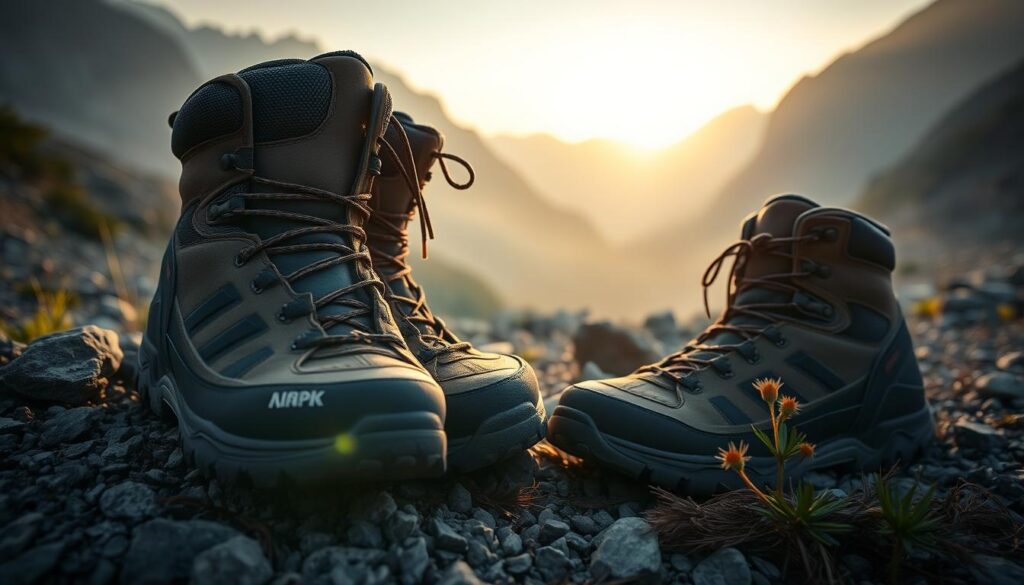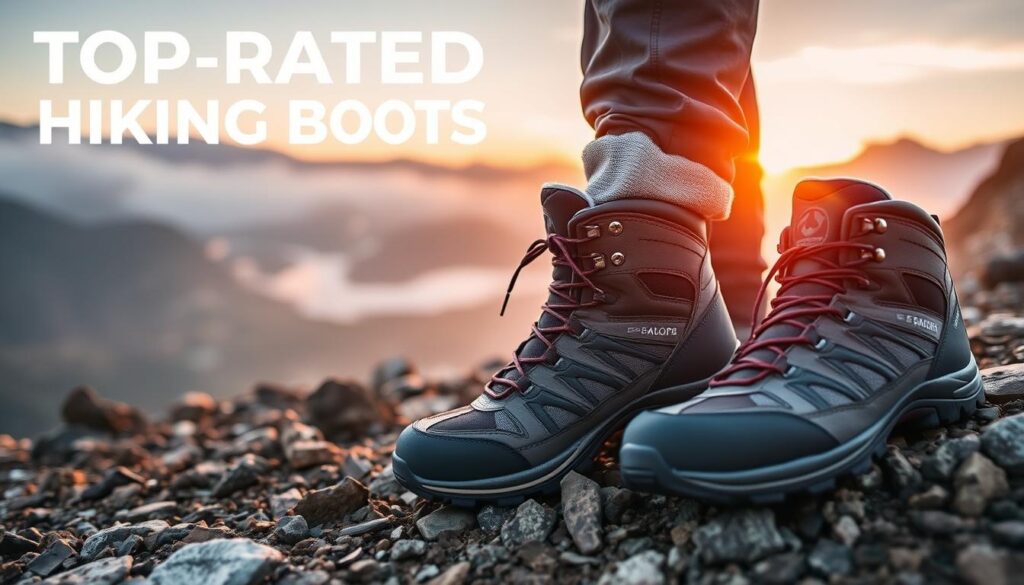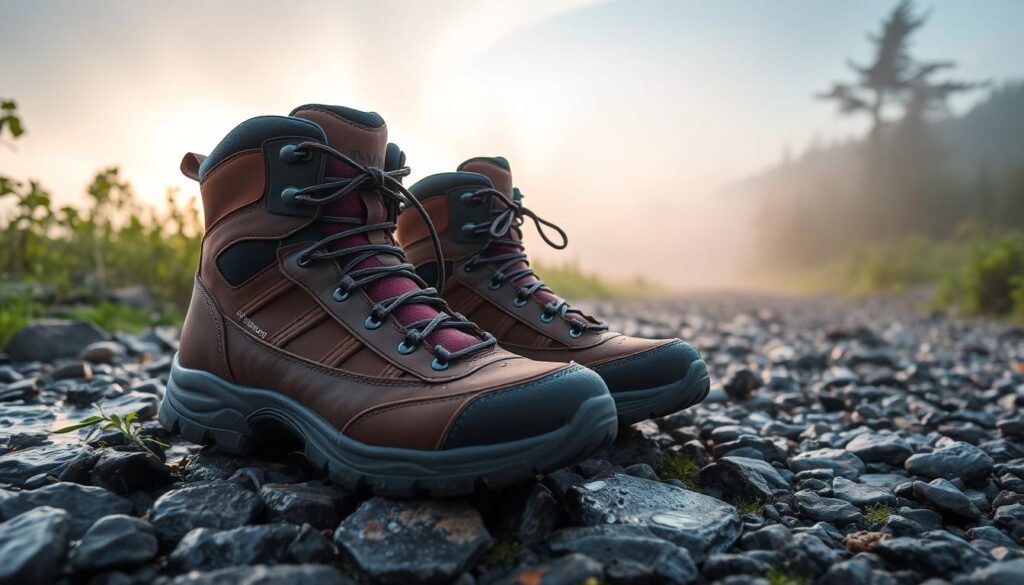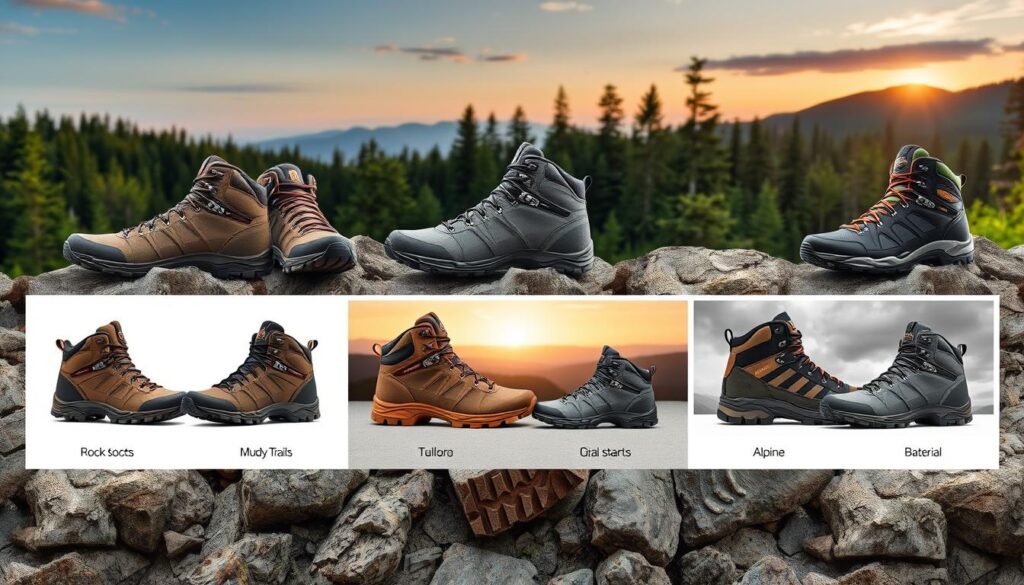As the sun rises, a new day begins, full of adventure. For those who love hiking, this is the best time to start. The best foot wear trails into daybreak.
In this guide, we’ll show you the best foot wear trails into daybreak. They’ll help you tackle any trail with confidence. Whether it’s wet or dry, these shoes are made for the early morning.
Key Takeaways
- Discover the best hiking shoes for early morning treks
- Learn how proper footwear can enhance your hiking performance
- Understand the key features to look for in quality hiking boots
- Explore the connection between comfort, safety, and hiking enjoyment
- Gain insights on selecting the right hiking boots for different terrain types
Understanding the Importance of Proper Hiking Footwear
Choosing the right hiking shoes is key to a great hike. The best foot wear trails into daybreak you pick can greatly affect your hike. They offer foot protection, traction, and ankle support. Best foot wear trails into daybreak are a must for any outdoor lover.
Impact of Footwear on Hiking Performance
The best foot wear trails into daybreak can boost your performance on trails. Boots with strong soles and good cushioning help you hike longer without getting tired. They also prevent injuries, letting you explore tough terrain with confidence.
Key Features of Quality Hiking Boots
- Durable, water-resistant materials for all-weather protection
- Rugged, high-traction soles for reliable grip on various surfaces
- Supportive midsoles and cushioning for comfort and shock absorption
- Reinforced toe boxes and heel counters for added foot protection
- Adjustable lacing systems for a secure and customizable fit
The Connection Between Comfort and Safety
Comfort and safety are closely linked in hiking shoes. Boots that fit right and support well prevent blisters and pain. This lets you enjoy the outdoors fully, without discomfort.
“The right hiking boots can make or break your outdoor adventure. Invest in quality footwear to ensure a comfortable and safe journey on the trails.”
Essential Factors to Consider When Choosing Hiking Boots
Choosing the best foot wear trails into daybreak is key for a comfortable and safe outdoor trip. You need to think about fit and sizing, weight, waterproofing, and breathability. These factors help pick the best hiking boots for you.
Fit and Sizing
A good fit is essential to avoid blisters and discomfort. Make sure the best foot wear trails into daybreak fit snugly around your heel. Your toes should have room to move but not too much. Try on boots with the socks you’ll wear and walk around to check the fit.
Boot Weight
The weight of your boots matters a lot. Choose lightweight boots to avoid fatigue. The terrain and how much you’ll carry also affect your choice.
Waterproofing and Breathability
Think about the weather and trails you’ll be on. Boots with waterproofing keep your feet dry. Also, look for breathable materials for air circulation and temperature control.
| Feature | Benefit |
|---|---|
| Waterproofing | Keeps your feet dry during wet conditions, providing protection against rain, snow, and puddles. |
| Breathability | Allows for better air circulation, reducing the buildup of heat and moisture, which can lead to discomfort and blisters. |
By looking at these key factors, you can find the best foot wear trails into daybreak. They will give you the fit, support, and protection you need for your outdoor adventures.
“The right pair of hiking boots can make all the difference in the world, transforming your outdoor experience from a chore to a joy.”

Best Foot Wear Trails Into Daybreak: Expert Recommendations
Going on a dawn hike needs top-rated hiking boots that can handle early morning trails. Our outdoor experts picked the best foot wear trails into daybreak for your next sunrise hike. This ensures your adventure is a success.
Morning Trail Performance Factors
For dawn hikes, you need expert picks that are great at traction, stability, and quick response. We looked at the best foot wear trails into daybreak that grip dewy surfaces, support on uneven ground, and let you move quickly.
Durability and Weather Resistance
Dawn hikes face unpredictable weather, from fog to rain. Our best foot wear trails into daybreak are made to last, with strong build and weather-proof materials. They keep your feet dry and comfy, no matter the weather.
Price-to-Quality Ratio Analysis
Getting the best foot wear trails into daybreak doesn’t have to cost a lot. We checked the value of our picks, ensuring great quality without high prices. Our choices offer excellent value and quality.

Start your next dawn hike with confidence, wearing the best expert picks. Find the best foot wear trails into daybreak that make your morning hike better and keep you moving into the day.
Waterproof vs. Breathable Hiking Boots: Making the Right Choice
Choosing between waterproof and breathable hiking boots can change your hiking game. Both have their benefits, but knowing what you need for your hikes is key.
Waterproof boots, like those with Gore-Tex, keep your feet dry in wet conditions. They’re great for muddy trails. But, they might not breathe as well, which can lead to sweaty feet and fatigue.
Breathable boots, on the other hand, focus on keeping your feet cool and dry. They’re perfect for hot weather or tough terrains. But, they might not keep your feet as dry as waterproof boots.
“The right hiking boot can make all the difference in the world, whether you’re navigating rocky trails or traversing lush forests.”
So, how do you pick? Think about where you hike. Waterproof boots are best for rainy or wet places. But, breathable boots are better for dry, warm hikes.
It’s all about what you prefer and what your hikes need. Knowing the good and bad of each type helps you choose the right boots for happy feet and great hikes.

| Feature | Waterproof Boots | Breathable Boots |
|---|---|---|
| Water Resistance | Excellent | Moderate |
| Breathability | Moderate | Excellent |
| Comfort in Warm Conditions | Moderate | High |
| Ideal Conditions | Wet, muddy trails | Warm, dry trails |
Top-Rated Hiking Boots for Different Terrain Types
Choosing the right hiking boots is key for a great dawn hike. Whether you’re on rocky paths, forest trails, or all-weather paths, there’s a trail-specific footwear for you. These boots support your every step.
Rocky Terrain Specialists
For rocky landscapes, you need versatile hiking boots with rugged soles. Look for boots with strong toe boxes, sturdy ankles, and deep lugs. These features grip uneven terrain well.
Forest Trail Champions
Forest trails need boots with different features. Choose lightweight, breathable boots with flexible soles. They help you stay agile and comfortable in the woods.
All-Weather Performers
For varied terrain and weather, get durable, waterproof boots. These boots keep your feet dry and protected, no matter the weather.
| Terrain Type | Recommended Boot Features | Top Picks |
|---|---|---|
| Rocky Trails | Reinforced toe box, sturdy ankle support, aggressive lugs | Salomon X Ultra 3 GTX, Merrell Moab 2 Ventilator |
| Forest Trails | Lightweight, breathable, flexible soles | Keen Targhee III, Columbia Newton Ridge Plus II Waterproof |
| All-Weather | Waterproof, durable construction, versatile traction | Hoka One One Speedgoat 4 GTX, Oboz Bridger B-Dry |

Think about the terrain and weather for your dawn hikes. This way, you can find the best trail-specific footwear for comfort and confidence.
Breaking In Your New Hiking Boots: Essential Tips
Getting a new pair of hiking boots is exciting. But, the real challenge is breaking them in right. This step can make your hike either comfortable or painful. Follow these tips for a smooth break-in, ensuring your boot comfort on dawn trails.
- Start Slow: Wear your new boots for short times at home or on easy trails. This helps your feet get used to the boots, avoiding sudden pain or blister prevention.
- Wear Thick Socks: Choose moisture-wicking, cushioned socks for extra support and padding. They reduce friction and blister risk during gradual wear.
- Apply Moleskin: Put moleskin or blister-prevention products on areas that rub, like heels and toes. This can prevent blisters during the break-in.
- Alternate Boots: If you have more than one pair, switch them on hikes. This lets each pair dry and keep their shape, improving the break-in.
- Listen to Your Feet: Watch for any discomfort or hot spots. Fix these right away by adjusting the fit or taking a break, instead of ignoring the pain.
By using these essential tips, you’ll smoothly transition into your new hiking boots. This sets you up for many enjoyable dawn hikes ahead.
| Tip | Description |
|---|---|
| Start Slow | Wear the boots for short periods around the house or on easy trails to allow gradual adjustment. |
| Wear Thick Socks | Opt for moisture-wicking, cushioned socks to minimize friction and reduce blister risk. |
| Apply Moleskin | Preemptively apply moleskin or blister-prevention products to high-friction areas. |
| Alternate Boots | Rotate between multiple pairs of boots to allow each pair to fully dry and maintain shape. |
| Listen to Your Feet | Address any discomfort or hot spots immediately to prevent blisters and ensure a comfortable hike. |
Maintaining Your Hiking Footwear for Longevity
Getting a good pair of hiking boots is key, but taking care of them is just as important. By using simple cleaning techniques and storage tips, you can make your gear last longer. This helps keep your gear longevity at its best.
Cleaning and Care Guidelines
After every hike, clean your boots well. Use a soft-bristle brush and warm water to get rid of dirt and mud. Don’t use strong chemicals, as they can harm the materials. Let the boots dry completely before you store them.
Storage Best Practices
- Keep your boots in a cool, dry spot, away from sunlight or heat.
- Use clean, dry newspaper or boot trees to keep their shape.
- Think about using a boot dryer or dehumidifier to stop moisture buildup.
When to Replace Your Boots
Hiking boots don’t last forever, even with good care. Watch for signs like worn-out soles, cracked leather, or bad waterproofing. Replace them every 300-500 miles or 1-2 years, depending on how often and hard you hike.
| Indicator | Replacement Recommendation |
|---|---|
| Worn-down Soles | Replace the boots |
| Cracked or Peeling Leather | Replace the boots |
| Compromised Waterproofing | Replace the boots or apply a waterproofing treatment |
By sticking to these boot maintenance tips and knowing when to get new boots, you’ll have reliable, comfy, and long-lasting footwear for your hikes.
Budget-Friendly Options Without Compromising Quality
Looking for hiking boots that won’t empty your wallet? There are many value picks out there. They offer great performance, durability, and comfort without the high price tag.
The Merrell Moab 2 Ventilator is a top choice for those on a budget. It has a strong Vibram sole, a breathable mesh upper, and a supportive midsole. All this for around $100 makes it a great deal.
| Boot Model | Price Range | Key Features | Terrain Suitability |
|---|---|---|---|
| Merrell Moab 2 Ventilator | $80 – $120 | Vibram sole, breathable mesh, supportive midsole | Day hikes, light backpacking |
| Columbia Newton Ridge Plus | $60 – $90 | Waterproof leather, lightweight, cushioned | Varied terrain, wet conditions |
| Xero Shoes Daylite Hiker | $90 – $120 | Minimalist design, flexible, wide toe box | Trails, off-road adventures |
The Columbia Newton Ridge Plus is another great affordable hiking boot. It has a waterproof leather upper, a cushioned midsole, and a durable outsole. Priced between $60 to $90, it’s a quality choice for various terrains and weather.
The Xero Shoes Daylite Hiker is perfect for those who like a minimalist feel. It’s flexible, has a zero-drop design, and a wide toe box. Priced between $90 and $120, it’s a budget-friendly option for a barefoot-inspired hike.
Finding the right affordable hiking boots is about finding quality without spending too much. These value picks show you can get great performance and comfort without breaking the bank. By looking at features, durability, and price, you can find cost-effective gear for your hikes.
Latest Innovations in Hiking Boot Technology
Hiking footwear has seen big changes, with new tech that boosts performance and is good for the planet. New materials, smart features, and eco-friendly options are changing how we hike. These advancements are making our early morning trails adventures better than ever.
Advanced Material Developments
Now, hikers get unmatched comfort and durability with new materials. Membranes like Gore-Tex keep feet dry while letting air in. Soles from Vibram add extra grip and protection.
Lightweight and flexible materials, like carbon fiber and EVA foams, absorb shock. They make every step feel right and comfortable.
Smart Features and Integration
Technology has made hiking boots smarter. Features like GPS, activity tracking, and heated insoles keep hikers connected and warm. These tech additions make hiking boots more than just footwear; they’re a key part of the hiking experience.
Eco-Friendly Options
The hiking boot world is going green, with brands focusing on eco-friendly choices. They use recycled and renewable materials and follow ethical making practices. These boots are top-notch and kind to the earth, perfect for hikers who care about both quality and the planet.


